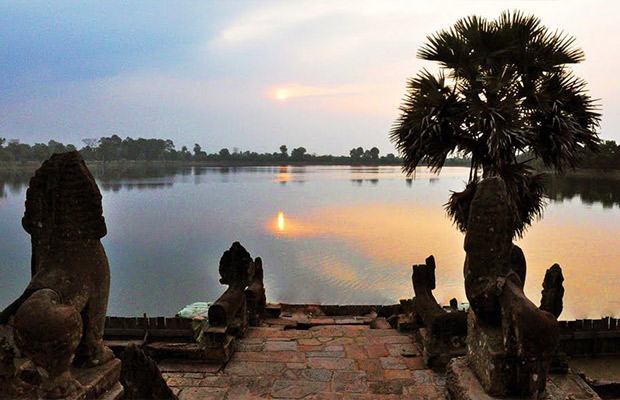
- Travel Name: Srah Srang
- Travel Destination: Siem Reap
Picturesque baray opposite Banteay Kdei. Originally constructed by the same architect that built Pre Rup. Remodeled in the 12th century as part of Jayavarman VII's massive building campaign. A multi-tiered landing platform on the west edge of the baray is adorned with naga balustrades and guardian lions. The very sparse remains of an island temple can be seen poking from the middle of the lake during the dry season when the water is low. Srah Srang offers a pleasant, less touristed sunrise alternative to Angkor Wat.
History of Srah Srang
It was dug in the mid-10th century, by initiative of Kavindrarimathana, Buddhist minister of Rajendravarman II. It was later modified around the year 1200 by Jayavarman VII, who also added the laterite landing-stage at its western side, probably because the East Baray had been overwhelmed by sediment and had begun malfunctioning. French archeological expeditions have found a necropolis close to it.
Background of Srang Srang
Srah Srang is a large lake (700 by 300 meters, 2,297 by 984 feet) with elegant landing terrace of superb proportion and scale.
Layout of Srah Srang
A majestic platform (landing stage) with leads to the pond. It is built of laterite with sandstone molding. The platform is in the shape of a cross with serpent balustrades flanked by two lions. At the front there is an enormous Garuda riding a three-headed serpent. At the back there is a mythical creature comprising a three-headed serpent, the lower portion of a Garuda and a stylized tail decorated with small serpent heads. The body of the serpent rests on a dais supported by mythical monsters.
The Site of Srah Srang
At present Srah Srang measures 700 by 350 m and is still partially flooded. As other barays, maybe there was a temple standing on an artificial island in the middle of it, as suggested by finding of a basement. The landing-stage, opposite the entrance to Banteay Kdei, is a popular site for viewing the sunrise. It is cruciform, flanked by nāga balaustrades which end with the upright head of a serpent, mounted by a garuda with its wings unfurled. The steps that lead down to the water are flanked by two guardian lions.
A 1600 sq. meter cemetery was discovered at the north-west corner of the reservoir. Mortuary jars containing cremated remains and other artifacts dating from the reign of Udayadityavarman II were excavated by B.P. Groslier

Copyright © 2025, Cambo Tours & Travel - Discover Authentic Travel Experience, All Rights Reserved.